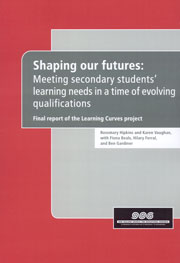
The Learning Curves project has documented changes in the subject and assessment choices offered to senior students in six medium-sized New Zealand secondary schools between 2002 and 2004 as the National Qualifications Framework and National Certificate of Educational Achievement (NCEA) reforms were progressively implemented. It has also investigated how students perceive and make their subject choices within the context of each school’s curriculum policies and practices.
This report documents findings from the third and final year of Learning Curves and is subtitled Shaping Our Futures: Meeting Secondary Students’ Learning Needs in a Time of Evolving Qualifications. It builds on findings from the first report, From Cabbages to Kings, which was released in mid-2002, and the second report, Shared Pathways and Multiple Tracks, which was released in April 2004.
Some key findings and discussions in this third report include:
- students studying across all three levels of the NCEA regard the assessment as a valuable qualification, and believe their teachers and parents do as well
- students are demonstrating increased sophistication in managing their assessments
- students produce different types of NCEA qualifications, allowing them to keep future ‘learning pathways’ open
- over-assessment is a de-motivating factor, but also an issue that can be addressed immediately by schools
- some students see themselves as “successful learners”, others as “successful collectors of NCEA credits”
- there are identifiable clusters of frequently combined subjects
In this research six case study schools (three in rural towns, three in cities) were selected to represent a diversity of student groups and contextual settings. In 2004 the principal and five heads of department (of English, mathematics, science, technology, and the arts) were interviewed, as they had been in 2002 and 2003. Students at Years 11–13 were surveyed in mid-2004 with some also participating in focus groups.
Shaping Our Futures differs in approach from the first two reports as it captures differences between the schools, rather than generalising patterns across them, as was the case with the previous reports.




